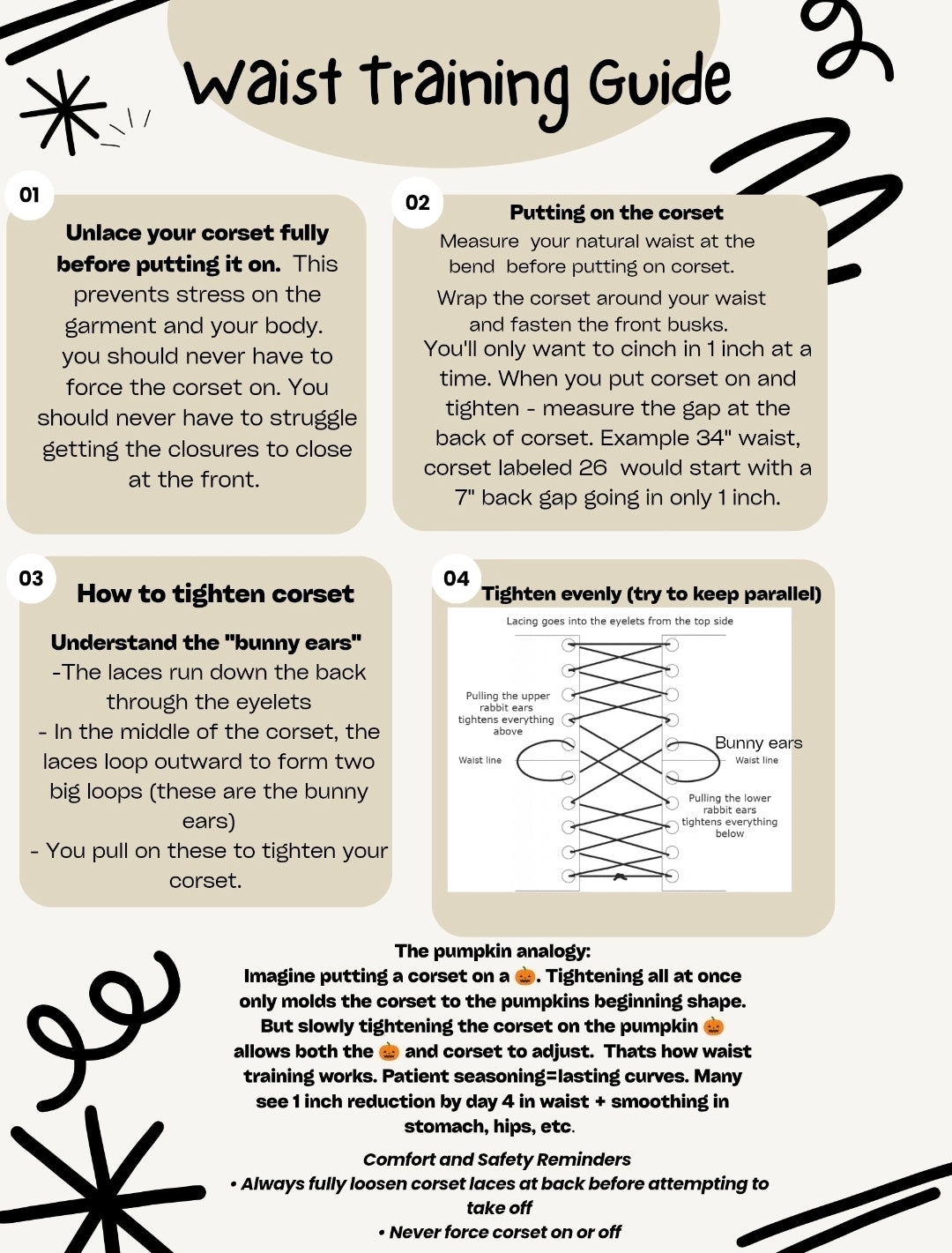Corset Seasoning & FAQ
Why Season Your Corset? And what is seasoning?
Our seasoning guidelines are designed to keep you safe and comfortable—especially if you’re new to waist training. Unlike outdated advice that encouraged wearing your corset as tight as possible on day one, our method eases your body into the process. Most people today are used to elastic, loose fabrics, so a rigid garment like a corset takes some getting used to.
Seasoning isn’t just about softening the corset—it’s about allowing your body to adapt and the fibers of the corset to settle properly. Over time, a well-seasoned corset hugs your body like a glove.
---
What is a Seasoning Schedule?
A seasoning schedule is a gradual plan for breaking in your corset safely. It helps your body adjust to the pressure and shape of the corset while allowing the garment to soften and mold to your curves.
Beginners often start with short periods of wear (1–2 hours) and gradually increase the duration over days or weeks.
Seasoning schedules are flexible: some people prefer structured plans, while others learn through trial and error.
The goal is always comfort and safety, not forcing a specific reduction or wearing time.
---
How Tight Should a Beginner Wear a Corset?
Starting too tight can be dangerous. In the past, corset makers recommended starting with just 3–4 inches of reduction. Today, some off-the-rack (OTR) corsets allow for 8–10 inches, but this is not recommended for beginners.
A modest starting reduction helps your body adjust safely, prevents injury, and makes the process enjoyable. Remember: your comfort comes first—corsets should never hurt, pinch, or cause bruising. We personally recommend only going in 1-2 inches during the first 14 days and 3 inches only after 21 days depending on your comfort. Or only going down an inch at a time as you lose an inch in your natural waist for best results and comfort combined.
---
The Gap at the Back of the Corset
With waist training, it’s recommended to have a gap at the back of your corset. This allows your body to adjust gradually and safely over time and allows you to size down! We try to stay anywhere between 2 (some people like wearing their corset close to fully closed) -8 inches gap at the back( allows for more reduction and especiallyif plan to size down it'll ast longer instead of sizing out of it. Any more than 8 inch gap can cause bowing of boning channels etc and is not recommended unless you're plus size over 42 inch natural waist then a 10 inch gap may be suitable depending on shape etc of corset.
Tight lacing, on the other hand, is the practice of trying to close the corset completely from the start or achieve extreme reductions. At Fitted4Royalty, we do not teach or promote tight lacing. It’s a personal choice for some people, but our approach focuses on comfort, safety, and sustainable waist training which leads to long lasting results, comfort, ease of wear, and extended longevity of your corset!
Difference Between Waist Training and Tight Lacing
Waist Training: Gradual, sustainable reduction of the waist over time. Focuses on body adaptation, comfort, and long-term results. A gap at the back is normal and belling at underbust and hips is normal during seasoning!
Tight Lacing: Extreme reduction with the goal of closing the corset completely. Can be risky for beginners and is not part of our recommended method.
---
Client Question:
“I’m wearing the corset as tight as I can, and it measures the same as my natural waist. Am I doing something wrong?”
Answer:
Nothing is wrong! Corsets have thickness, so even if the external measurement matches your natural waist, your internal waist is likely 1.5–2 inches smaller. If the corset fits properly and feels comfortable, that reduction is perfect. Over time, your body may comfortably reduce further, but patience is key.
---
How Long Does It Take to Season a Corset?
It depends. Every body is different, and corsets vary by brand, materials, and construction. Some people may season a corset in 10 hours; others may take over 100. The goal is to wear your corset safely while gradually helping it mold to your body.
Think of it like learning a new skill: some people prefer strict rules, others prefer trial-and-error. Both approaches work, and it’s okay to start with guidelines and adapt as you gain experience.
---
Corset Seasoning Analogies
Hard Contact Lenses: Hard lenses reshape the cornea gradually. You can’t wear them all day at first—starting slowly prevents irritation. Similarly, your body needs time to adjust to a new corset.
Weight Lifting: Beginners often need a trainer to learn proper form and build strength. Over time, you can adapt and personalize your routine. Corseting works the same way—seasoning builds your “corset strength.”
Pumpkin Analogy: Think of your waist like a pumpkin. If you put a corset on as tight as possible right away, the corset will only take the shape of the pumpkin—it won’t really change it. But if you allow the pumpkin to “season” or soften, and you gradually tighten the corset, the pumpkin (your waist) will start molding to the corset and the corset will mold to your waist. This gentle process ensures a more comfortable, natural fit, rather than forcing your body to adapt too quickly.
---
Tips for Safe Waist Training:
Start with a corset suited to your experience and body type. You may not be able to go as curvy as you want righr away but you can work up to ut as your natural curves comes in more pronounced.
Don’t rush reductions—listen to your body.
Avoid wearing a corset that pinches, bruises, or causes pain.
Follow your personal seasoning schedule, adjusting as your body adapts.
Remember: your body is priceless—corsets are replaceable.
